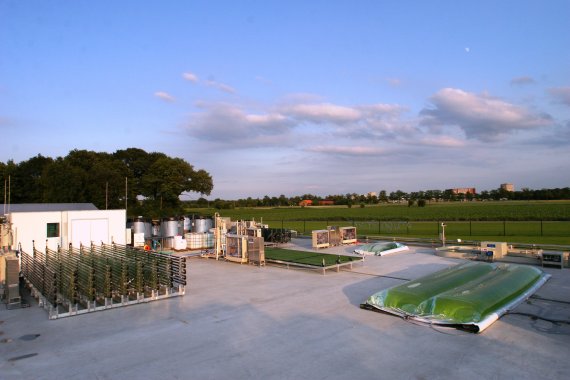The AlgaePARC in Wageningen.
It is possible to make algae harvesting up to 100 times more energy-efficient by adjusting the harvesting process. This is an important finding as algae are a potential source of sustainable raw materials. After ‘sticky algae’ have been added, the single-celled organisms sink to the bottom of their own accord and then it is easy to remove the remaining water. This is shown in Bioprocess Technology student Sina Salim’s doctoral thesis, which he will be defending on 6 September. At present, harvesting algae costs half the energy that they produce. That is because algae grow in tanks at such low densities that you need centrifuges to separate them from the water. This process can be more energy-efficient if the algae form ‘flakes’ and sink to the bottom of their own accord. Then you only need to centrifuge the sludge at the bottom. There are a variety of methods for getting algae to stick together. Most involve masking the negative charges on the outside to stop the algae repelling each other. To do this you can grow algae in more alkaline environments, add positively-charged salt particles or let them grow with slime-producing bacteria. ‘But slime-producing bacteria contaminate the algae and also need sugar themselves,’ says Salim. Indeed, all the known methods have their downsides.
Not yet profitable
So Salim looked for algal species that automatically form so-called biofilms; they produce miniscule threads that let them stick together. ‘Think of the green layers you see on rocks next to rivers,’ says Salim. He found 16 suitable candidates in a large collection of algae in Texas. Four turned out to be successful in experiments. When Salim added his sticky algae to normal populations, the algae joined to form flakes. He let them sink to the bottom and then centrifuged the slime. Depending on the algal species used, the centrifuging process used 60 to 100 times less energy. In the case of the most promising species, flake formation hardly had any negative impact on growth rates and raw material production. His findings lead to attractive savings but Salim is quick to say that large-scale applications for algae are still a long way off. They can potentially be used for non-fossil oil, protein without the need for livestock or plants and omega-3 and omega-6 unsaturated fatty acids without the need to fish the oceans. But more research is needed to make all the process steps more efficient. At present, algae cultivation generally uses more fossil fuels than it produces in biofuels and raw materials. According to Salim, ‘Anyone who tells you that you can make a profit from algae-biodiesel within five to ten years is talking rubbish.’

